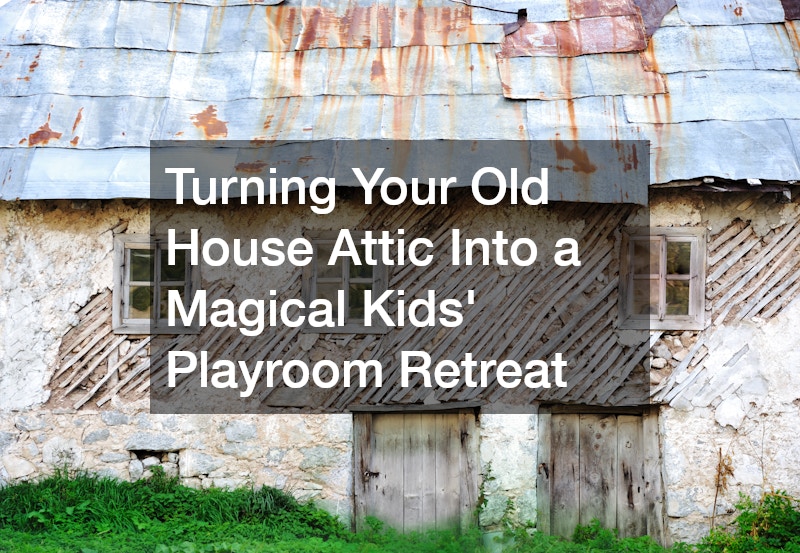
Turning Your Old House Attic Into a Magical Kids Playroom Retreat
In the heart of every old house lies hidden potential—spaces often overlooked, yet rich with opportunity. One such treasure trove is the attic. If you’ve ever climbed the creaky stairs to an old house attic, chances are you’ve seen dusty boxes, forgotten furniture, and cobwebs. But what if, instead of storage overflow, your attic became a magical hideaway for your children? Transforming an old attic into a kids’ playroom retreat can breathe new life into your home, spark joy in your family, and provide a safe, imaginative haven for play and creativity.
This comprehensive guide explores how to unlock the possibilities of an old house attic and convert it into a dreamy, functional playroom—complete with safety, style, and a touch of magic.
What Are the Benefits of Transforming an Old House Attic into a Kids’ Playroom?
Utilizing Underutilized Space
One of the most compelling reasons to renovate your old house attic is to put wasted square footage to good use. Attics are often used for storage, but much of that can be reorganized, relocated, or downsized. In return, you reclaim a large, open space that’s ready to serve your family in a more meaningful way.
Increasing Property Value
A finished attic increases your home’s usable square footage, which can boost its market value. Real estate agents and appraisers recognize the added utility of a livable attic, especially one that’s thoughtfully designed for family use. A playroom is an excellent investment for families with young children or those looking to appeal to buyers with kids.
Creating a Dedicated Play Area
Children thrive when they have their own space to express themselves, and a playroom lets you contain toys, games, and art supplies in one spot—keeping the rest of the house organized. The old house attic becomes a sanctuary for creativity and learning.
Enhancing Home Aesthetics
A beautifully designed attic playroom contributes to the overall look and feel of your home. Instead of a dark, neglected space, your attic becomes a warm, cheerful room that complements your interior style and offers another dimension of charm.
Encouraging Imaginative Play
The sloped ceilings and cozy corners of an attic are ideal for fostering imagination. Kids can turn those quirky angles into castles, spaceships, or reading nooks. With the right design, you can create an environment that fuels your child’s sense of wonder and adventure.
How Do I Childproof an Old House Attic?

Securing Windows and Doors
Safety is a top priority when transforming an attic. Ensure that all windows lock securely and consider adding safety latches to prevent accidental openings. Interior attic doors should have secure locks and be easy to open from the inside.
Ensuring Stable Flooring
Most old house attic floors were not built with daily foot traffic in mind. Work with a custom home builder to reinforce flooring, ensuring it can handle weight, impact, and lots of little footsteps running around. Adding a padded carpet or soft flooring is an excellent way to provide both comfort and safety.
Installing Safe Electrical Outlets
Old homes often have outdated or unsafe electrical systems. Upgrade outlets with tamper-resistant models, ensure all wiring is up to code, and avoid overloading circuits. Childproof outlet covers are a must.
Using Non-Toxic Materials
Choose non-toxic paints, adhesives, and finishes throughout the space. When hiring a custom home builder, ask them to prioritize materials that meet low-VOC and child-safe standards.
Adding Proper Lighting
Dark corners are not ideal for play. Incorporate ample lighting to eliminate shadows and enhance visibility. Consider dimmable lights for a relaxing ambiance in the evening.
What Are Some Design Ideas for an Attic Playroom?
Choosing a Theme
From enchanted forests to outer space, themed playrooms make the experience more immersive. Let your child’s personality guide the theme, or choose one that evolves with age.
Color Schemes that Inspire
Bright, playful colors stimulate creativity and joy. Soft pastels or nature-inspired hues can create a calming retreat. Whichever palette you choose, balance bold accents with neutral tones to avoid overstimulation.
Creating Zones for Different Activities
Divide the room into areas dedicated to specific activities—reading, art, building, and pretend play. This structure helps children stay engaged and supports developmental growth like learning a second language or practicing fine motor skills.
Selecting Durable Furniture
Choose furniture made to withstand wear and tear—like wipeable surfaces, rounded corners, and sturdy frames. Pieces that double as storage will help keep the room organized.
Incorporating Art and Craft Areas
Every playroom should have a designated spot for creativity. A mini art studio, complete with paper rolls, crayons, paints, and child-sized easels, invites hours of fun while promoting artistic development.
How Can I Maximize Space in an Attic Playroom?

Utilizing Vertical Storage
Think up! Use wall-mounted racks, shelves, and hanging organizers to keep toys and supplies accessible yet off the floor.
Choosing Multi-Functional Furniture
A bench that opens for toy storage or a table that doubles as a chalkboard saves space and adds practicality. These items are essential in an old house attic where every inch counts.
Implementing Built-In Cabinets
Custom cabinet installation makes the most of awkward sloped ceilings and provides ample storage. Built-ins help keep clutter at bay and give the playroom a polished, permanent look.
Creative Shelving Solutions
Use ladder-style shelves or floating shelves to display books, toys, or educational materials. They’re perfect for showcasing a rotation of interests and creating visual variety.
Making Use of Nooks and Crannies
Turn those oddly shaped corners into cozy hideouts, reading cubbies, or mini puppet theaters. In an old house attic, these quirks become assets when used creatively.
What Are the Necessary Steps for Renovating an Old House Attic?
Initial Assessment and Planning
Before doing anything, assess the condition of the attic. Look for signs of moisture, pests, or structural damage. Create a layout that includes zoning, insulation, and utilities.
Obtaining Permits and Approvals
Depending on your municipality, you may need permits for electrical, plumbing, or structural changes. A good contractor or custom home builder can help navigate local codes.
Insulating and Ventilating
Proper insulation is crucial to keep the playroom comfortable year-round. Consider spray foam insulations for superior coverage and energy efficiency. Ventilation is equally important—install soffit vents, ridge vents, or even a small HVAC duct.
Addressing Structural Integrity
Reinforce beams, joists, and supports if needed. This is particularly important in older homes where building standards have changed.
Final Touches and Decoration
Once construction is complete, bring the space to life with rugs, wall decals, toys, and fun decor. Let your child help decorate to build excitement and ownership of their new room.
What Are Some Budget-Friendly Tips for Attic Transformation?

Repurposing Existing Furniture
Old dressers, bookshelves, or tables can be given new life with a coat of paint or minor modifications. Not only does this save money, but it’s also a sustainable choice.
Simplifying Design Elements
You don’t need an over-the-top design to impress. Use color, creativity, and thoughtful layout to make a big impact without breaking the bank.
Efficient Budget Allocation
If you’re hiring demo contractors or builders, get multiple quotes and prioritize spending on structure, safety, and insulation. Decorative elements can be upgraded over time.
How Should I Handle Temperature Control in an Attic Playroom?
Choosing Proper Insulation
Insulation is your first line of defense against extreme attic temperatures. Again, spray foam insulations are an excellent choice for sealing all the little cracks and gaps typical of older homes.
Installing Heating and Cooling Systems
Mini-split HVAC systems offer precise temperature control without requiring extensive ductwork—ideal for attics.
Utilizing Ventilation Techniques
Ventilation keeps air moving, preventing it from getting too hot in summer or musty in winter. Ridge vents, gable vents, and fans can all help.
Incorporating Fans or Mini-Splits
Ceiling or wall-mounted fans help circulate air, especially in the summer. A ductless mini-split can both heat and cool, making it a smart, year-round solution.
Using Thermal Curtains and Blinds
Install roller shades or thermal curtains to help regulate sunlight and improve insulation. They’re also great for nap time or creating a movie-watching atmosphere.
What Are the Best Flooring Options for an Attic Playroom?
Carpet for Comfort and Safety
Soft carpeting is cozy, absorbs sound, and provides a cushioned surface for play and tumbles. Choose low-pile or carpet tiles for easy cleaning.
Wooden Floors for Durability
Hardwood floors can add character to an old house attic and are easy to clean. Just add area rugs for comfort and warmth.
Laminate for Affordability
Laminate offers the look of wood at a lower cost and with added resistance to scratches. It’s a great all-around option.
Cork for Eco-Friendliness
Cork flooring is naturally soft, warm, and sustainable. It also resists mold and mildew, making it a healthy choice for kids.
Vinyl for Easy Maintenance
Vinyl is water-resistant, budget-friendly, and comes in a variety of fun patterns—perfect for a playroom.
Don’t forget to check for moisture, especially if your attic has ever had water issues. Resolve leaks before installing flooring.
How Can I Ensure Proper Lighting in an Attic Playroom?

Lighting plays a crucial role in making your old house attic feel warm, inviting, and functional. A well-lit attic playroom isn’t just more visually appealing—it also supports your child’s mood, safety, and ability to focus during different activities. Since attics are often darker and tucked away from main light sources, paying special attention to both natural and artificial lighting is key to creating a truly magical retreat.
Natural Lighting Enhancements
Natural light is one of the best ways to make an attic feel open and cheerful. Start by maximizing any existing windows or skylights. Keep window coverings light and airy to allow daylight to pour in. If your attic currently lacks natural light, consider adding a dormer window or skylight. Not only do these features brighten up the space, but they also add architectural charm and potentially increase your home’s resale value.
In old house attic renovations, it’s also important to evaluate existing structures—such as chimneys—that might block light. If you’ve recently had chimney repairs, this is a great time to assess whether they obstruct window access or cast unwanted shadows. Positioning mirrors opposite windows can also reflect and amplify natural light throughout the room.
Layering Light Sources
Rather than relying on a single overhead bulb, layering different types of lighting creates depth and flexibility. Start with ambient lighting—this is your primary source that illuminates the whole space. Recessed lighting, flush-mount ceiling lights, or track lighting work well for attics with low or sloped ceilings. Follow with task lighting, like adjustable desk lamps or under-shelf lighting in reading nooks and craft corners. Finally, add accent lighting—string lights, LED strips, or novelty lamps—for personality and fun.
Choosing Child-Safe Fixtures
When selecting fixtures for a kids’ space, prioritize safety and durability. Avoid floor lamps that can easily be knocked over or fixtures with hot bulbs that could pose a burn risk. Opt for enclosed LED lights, which are energy-efficient, cool to the touch, and long-lasting. Ceiling-mounted or wall-mounted lights are ideal in a playroom—especially one in a tighter old house attic—where space is limited and kids are active.
Different Lighting for Different Zones
A playroom with distinct zones—such as art, reading, building, or imaginative play—benefits from lighting that supports each activity. Task lighting over a table helps with detailed work like drawing or puzzles, while soft lighting in a reading nook creates a cozy atmosphere. A pretend play area can be illuminated with whimsical string lights or color-changing LEDs for an imaginative vibe.
What Storage Solutions Work Best for an Attic Converted to a Playroom?
Baskets and Bins for Organization
Color-coded or labeled bins make it easy for kids to help with cleanup. They’re portable and versatile.
Under-Furniture Storage
Choose beds, benches, or tables with drawers or open cubbies underneath.
Closet Organizers and Hooks
If your attic has a small closet, outfit it with adjustable shelves and hanging organizers to maximize utility.
Cubby Shelves for Toy Management
Cubbies provide easy access for little hands and can double as seating with a cushion on top.
Custom Built-In Solutions
For a polished, integrated look, custom shelves, desks, and granite counter workspaces can be built into the room’s layout. While granite counter might not seem like a traditional playroom element, it can work well in a craft or science corner where durability and easy cleanup are key.
Transforming your old house attic into a magical kids’ playroom retreat is one of the most rewarding home improvement projects you can take on. From enhancing property value to providing your children with a dedicated space for learning, creativity, and fun, the benefits are endless. With thoughtful planning, smart storage solutions, and a bit of imagination, your attic can evolve from a forgotten corner to the heart of your home’s play and laughter.
Whether you’re hiring custom home builders, consulting with demo contractors, choosing cabinet installation layouts, or picking out roller shades and flooring that resists water, each detail contributes to building a joyful, functional space your kids will cherish. So go ahead—dust off that attic and let the transformation begin!

